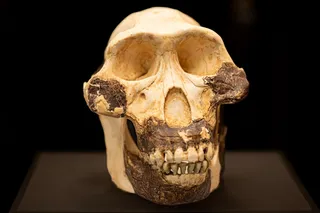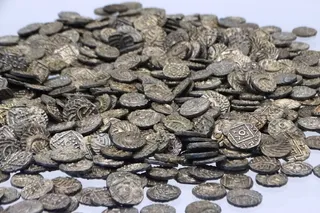The scenes carved into a wall of the ancient Egyptian temple at Deir el-Bahri tell of a remarkable sea voyage. A fleet of cargo ships bearing exotic plants, animals, and precious incense navigates through high-crested waves on a journey from a mysterious land known as Punt or “the Land of God.” The carvings were commissioned by Hatshepsut, ancient Egypt’s greatest female pharaoh, who controlled Egypt for more than two decades in the 15th century B.C. She ruled some 2 million people and oversaw one of most powerful empires of the ancient world.
The exact meaning of the detailed carvings has divided Egyptologists ever since they were discovered in the mid-19th century. “Some people have argued that Punt was inland and not on the sea, or a fictitious place altogether,” Oxford Egyptologist John Baines says. Recently, however, a series of remarkable discoveries on a desolate stretch of the Red Sea coast has settled the debate, proving once and for all that the masterful building skills of the ancient Egyptians applied to oceangoing ships as well as to pyramids.
Archaeologists from Italy, the United States, and Egypt excavating a dried-up lagoon known as Mersa Gawasis have unearthed traces of an ancient harbor that once launched early voyages like Hatshepsut’s onto the open ocean. Some of the site’s most evocative evidence for the ancient Egyptians’ seafaring prowess is concealed behind a modern steel door set into a cliff just 700 feet or so from the Red Sea shore. Inside is a man-made cave about 70 feet deep. Lightbulbs powered by a gas generator thrumming just outside illuminate pockets of work: Here, an excavator carefully brushes sand and debris away from a 3,800-year-old reed mat; there, conservation experts photograph wood planks, chemically preserve them, and wrap them for storage.
Toward the back, a padlocked plywood door seals off an adjacent cave. As soon as the door is unlocked, a sweet, heavy, grassy smell like that of old hay wafts out, filling the area with the scent of thousands of years of decay. In the thin beam of a headlamp, one can make out stacked coils of rope the color of dark chocolate receding into the darkness of the long, narrow cave. Some of the bundles are as thick as a man’s chest, and the largest may hold up to 100 feet of rope.
The rope is woven from papyrus, a clue that it may have come from the Nile Valley, where the paperlike material was common. Archaeologists found it neatly, professionally coiled and stacked, presumably by ancient mariners just before they left the shelter of the cave for the last time.
Boston University archaeologist Kathryn Bard and an international team have uncovered six other caves at Mersa Gawasis. The evidence they have found, including the remains of the oldest seagoing ships ever discovered, offers hard proof of the Egyptians’ nautical roots and important clues to the location of Punt. “These new finds remove all doubt that you reach Punt by sea,” Baines says. “The Egyptians must have had considerable seagoing experience.”
Digging in Egypt was supposed to be a side project for Bard and her longtime research partner Rodolfo Fattovich, an archaeologist at the Orientale University of Naples. The two scholars have spent much of their careers excavating far to the south of Mersa Gawasis, uncovering the remains of ancient Axum, the seat of a kingdom that arose around 400 B.C. in what is now northern Ethiopia and Eritrea. When a 17-year civil war in Ethiopia ended in the early 1990s, Fattovich and Bard were among the first archaeologists to return to digging there.
Neither is a stranger to sketchy situations. Fattovich was working in the Ethiopian capital, Addis Ababa, in 1974 when a coup toppled the country’s monarchy. Bard, who has degrees in art and archaeology, spent a year making the sometimes dangerous overland trip from Cairo to Capetown in the mid-1970s. She often wears a red T-shirt reading “Don’t Shoot—I’m an Archaeologist” in more than a dozen languages.
Their time at Axum was cut short by another war. In 1998 fighting between Ethiopia and Eritrea flared up while Fattovich and Bard were excavating a collection of tombs just 30 miles from the border. The archaeologists were forced to flee, driving more than 200 miles south through the Simian mountains of Ethiopia on a one-lane dirt road.
With the instability in Ethiopia, Fattovich and Bard were unsure if they would be able to resume digging there. They decided to head to Egypt, where archaeologists had long been searching for evidence of maritime trade links between that nation and the possibly mythical kingdom of Punt. Fattovich, a voluble Italian with a bum knee, remembered reading about some scattered rock mounds found in the 1970s along the Red Sea. “We decided, why not go investigate?” Fattovich says. “But when we got there, the site looked very disappointing. There were just a few shrines, nothing impressive.”
Beginning in 2002, they spent several weeks each year searching the coastal cliffs and the dried-up lagoon for signs of a harbor that might have sheltered merchant ships like those depicted in Hatshepsut’s wall carvings. Then, on Christmas morning in 2004, Bard was clearing what she thought might be the back wall of a rock shelter when she stuck her hand through the sand into an open space. Clearing away the drifts of sand and rock revealed a hemispherical cave about 16 feet across and 6 feet high. Its entrance was a carved rectangular opening, clearly not a natural formation.
Inside, the archaeologists found shattered storage jars, broken boxes fashioned out of cedar planks, and five grinding stones. A piece of pottery inscribed with the name of Amenemhat III, a pharaoh who ruled Egypt around 1800 B.C., helped the team pinpoint the cave’s age.
Not long afterward, another cave entrance emerged from the loose sand underneath a coral overhang. Inside was a chamber that made the first discovery look cramped: a gallery about 15 feet across, some 70 feet long, and tall enough for a short man to move around freely. The cave’s entrance was reinforced with old ship timbers and reused stone anchors, the first conclusive evidence of large-scale Egyptian seafaring ever discovered.
More planks had been reused as ramps, and the cave floor was covered in wood chips left by ancient shipwrights. Other debris included shattered cups, plates, and ceramic bread molds, as well as fish bones. The cave’s dimensions resembled those of standard Egyptian workers’ barracks such as those found near the pyramids at Giza.
Over the past seven years, Fattovich and Bard have uncovered the hidden remnants of the ancient harborside community, which overlooked a lagoon more than a mile across. In addition to eight caves, they have found remains of five mud-brick ramps that might have been used to ease ships into the water and a shallow rock shelter used for storage and cooking. They work in the winter, when temperatures in the desert hover in the high 70s and the poisonous vipers that infest the caves are hibernating. Neither scientist was eager to spend much time in the caves: Fattovich describes himself as claustrophobic, and Bard has a deep-seated fear of snakes.
Evidence connecting Mersa Gawasis to Punt piled up both inside and outside the caves. A few hundred yards from the cliffs, piles of crumbled stone and conch shells a few feet high are evidence of altars the seafarers built north of the harbor entrance. They included stones carved with inscriptions that specifically mention missions to Punt. Timbers and steering oars similar to those on ships depicted in Hatshepsut’s wall carvings were recovered in sand both inside and outside the caves. Many of the artifacts were riddled with telltale holes made by saltwater shipworms. The team even found fragments of ebony and pottery that would have come from the southern Red Sea, 1,000 miles away.
As if that weren’t enough, among the remnants of 40 smashed and empty crates found outside one cave were two sycamore planks marked with directions for assembling a ship. One of them bore an inscription still partly legible after 3,800 years: “Year 8 under his majesty/the king of Upper and Lower Egypt … given life forever/…of wonderful things of Punt.”
“It’s really rare that you have all the evidence that fits together so nicely,” Bard says.
While the windfall of Mersa Gawasis artifacts has answered some questions, it has raised others. For instance, how did the expeditions to Punt actually work, and how did the Egyptians construct vessels that could make a round-trip voyage of up to 2,000 miles?
Squatting in the humid heat of one of the Mersa Gawasis caves, Cheryl Wardunwraps a huge chunk of cedar as thick as a cinder block. Salt crystals on the wood glitter in the light of her headlamp. Ward turns the block in her hands and explains that it was once part of a plank from a ship’s hull. From its width and curvature, she estimates the original ship would have been almost 100 feet long. “The size and magnitude of this piece are larger than anything we have for any [other] Egyptian ship, anywhere,” she says.
Ward, a maritime archaeologist at Coastal Carolina University in Conway, South Carolina, spent three years building a full-scale reconstruction of a ship that would have docked in the lagoon of Mersa Gawasis. Ward has determined that unlike modern vessels, which are built around a strong internal frame, the Egyptian ship was essentially one giant hull. The curious construction meant that the craft required much larger timbers for strength. The wood was also cut thicker, with enough extra width to compensate for damage by shipworms. Some of the ship parts preserved in the Mersa Gawasis caves are more than a foot thick. “One of the features of Egyptian architecture is overbuilding,” Ward says. “You can see similar safety features in the construction of these ships.” Ward’s archaeological experiment needed 60 tons of Douglas fir as a stand-in for the Lebanese cedar used by the ancient Egyptians.
The Egyptian ships were also unique in that they were held together with mortise-and-tenon joints, tab-and-slot fittings that needed no metal fasteners and could be taken apart and put back together again. For added strength, the individual timbers were carved with curves that nested into adjacent parts, a little like puzzle pieces. “From the very beginning, the Egyptians were building boats that could be disassembled, and that makes them different from anyone else,” Ward says. “They were using the shapes of the planks to lock each of the pieces into place.”
Shadowed by a support boat for safety, Ward and a crew of 24—including her two sons—sailed their 66-foot reconstruction, called Min of the Desert, on the Red Sea for two weeks, setting out from Safaga, a modern port not far from Mersa Gawasis. The team had low expectations; the professional long-distance sailor who captained the two-week-long voyage likened the wide, flat-bottomed craft to “a giant wooden salad bowl” the first time he saw it.
Yet once under way, the ship proved agile and fast. During an unexpected storm, it weathered 10-foot waves and winds over 20 knots, and the two massive steering oars trailing the ship’s hull helped keep it on course. “In stormy weather it just surfed,” Ward recalls, hefting the plank in her hands. At one point, the ship hit 9 knots, or about 10 miles an hour, with most of its sails furled. That’s about three times as fast as an average modern sailboat, not too shabby for a craft carved with stone and copper tools.
For all the skill and craftsmanship evident in the Mersa Gawasis caves, ancient Egypt’s ocean voyages were most likely an exception to the usual modes of trade, born out of necessity in order to obtain exotic raw materials. For most of Egypt’s history, goods from Punt moved along established caravan routes via the upper Nile and across the eastern desert before cutting through modern-day Sudan. But around the time Mersa Gawasis came into use, it seems a hostile new kingdom to the south cut Egypt off from its supply of aromatic incense and resins. “If they could have gone overland, it was much easier than bringing timbers from Lebanon, building ships on the upper Nile, taking them apart and carrying them across the desert,” Bard says. “They weren’t stupid—no one wants to do things the hard way. But geopolitically, they had no other choice.”
On the basis of the speeds Min of the Desert reached on its experimental voyage, Ward estimates that the endeavor would have taken at least four months, and probably more: a month to assemble the ships, a month to sail to Punt, a month and a half or more to sail back against the prevailing winds, and a month to disassemble the ships and prepare for the trek back across the desert. Fattovich suggests that there were probably just 15 to 20 expeditions over some 400 years, about one every two decades.
Even for a civilization that built the pyramids, these expeditions would have been a tremendous logistical challenge. The closest shipyards were in Qena, a city on the Nile not far from the great temples of Luxor, Karnak, and Thebes. Four hundred miles south of modern Cairo, Qena was the closest point on the Nile to the Red Sea and probably the starting point for voyages to Punt.
From Qena, expeditions would have had to trek east across 100 miles of desert, following channels cut by rare rainstorms—or wadis—until they arrived at the coast. Mersa Gawasis was an intermediate staging point where the expeditions could reassemble their ships and prepare for the long voyage south.
Today Egypt’s Red Sea coast is almost completely lifeless, as though the sandy beach is simply an extension of the desert that stretches 100 miles inland to the Nile. “Here we are, in the middle of nowhere,” Fattovich says. “For Egyptians this was the equivalent of what a moon base will be in 100 years—very strange, very difficult.”
The carefully chosen harbor met a number of requirements for ancient sailors. It was sheltered from the waves and wind, its mouth was deep enough to clear the reefs that line the Red Sea coast, and the fossilized coral cliffs could be dug out easily. To top it off, Mersa Gawasis was a sort of marine oasis. Organic remains excavated in and around the caves helped the archaeologists reconstruct an environment very different from the expanse of sand and stone that surrounds the dig today. The inlet was once lined with mangrove trees and reeds. Shallow, calm water would have been perfect for launching ships. “Four thousand years ago, this was an ideal harbor. It’s a perfect place for ships to be built,” Bard says. “And it’s the shortest distance between Qena and the Red Sea.”
Like a modern space mission, the expeditions had to be entirely self-sufficient. Though the team did find freshwater sources not too far from the caves, everything else would have been carried across the desert. The ships themselves were disassembled plank by plank and probably loaded onto donkeys for the long trek. And each expedition brought with it not just the ships themselves but months’ worth of food, rope, tools, and provisions for the voyage south.
All this took tremendous manpower. An inscription on a stone found atop the cliff commemorating a voyage that set sail around 1950 B.C. lists a labor force of 3,756 men, 3,200 of them conscripted workers. “These were complicated and expensive operations in Egyptian times,” Fattovich says.
After about 400 years, Mersa Gawasis fell out of use. It was probably abandoned because there was no longer enough water in the lagoon to float ships, and perhaps overland links improved or other harbors were used. The last sailors to use the lagoon sealed up their ropes and shelters behind mud brick and sand to await expeditions that never came. For four millennia, the caves remained perfectly intact.
This year’s dig at Mersa Gawasis may well be the last. The wood found in the caves has been carefully photographed, cleaned, and sealed in special vacuum bags for storage on shelves at the back of the caves. Of the eight caves the team has located, six have been thoroughly studied. The last two are blocked by fallen rock and sand. Clearing them out could cause a total collapse. Not long before the team finished for the season, they dispatched a three-foot-long robotic snake equipped with a camera built by a team from Carnegie Mellon University to look inside. But a small pile of rubble a few feet inside the cave opening proved the snakebot’s undoing—it couldn’t make it up the 45-degree slope. The robot’s handlers hope to return and try again with a different design; if they find something remarkable, say, huge pieces of timber or even a whole vessel, there is a chance the caves would be opened.
In the meantime, the site is guarded 24 hours a day, and Bard says locals know there’s no gold inside, just old pieces of wood. So even with political chaos engulfing Egypt, it should be safe from looters. She and Fattovich are now heading south for one last search, determined to find the trading fleet’s actual destination. “I’ve spent my life searching for Punt,” Fattovich says. “I would like to conclude my career with a final excavation to locate the harbor of Punt.”
Sitting on the shore a short walk from the caves, waves gently lapping at the stony beach, Bard says she’s been studying satellite images of the southern Red Sea to pinpoint harbors Egyptian sailors might have used to trade for the “wonderful things of Punt.” “We’re already thinking about where we might go next,” she says, looking out to the sea.
An Antiquities Minister Resumes Power
When revolution in Egypt broke out against longtime president Hosni Mubaraklast January, the upheaval left Egyptologists fearing for the nation’s ancient treasures. The initial chaos drove many of the estimated 1,000 foreign archaeologists working in the country to abandon dozens of sites. Vandals seized the opportunity and looted Saqqara, a massive burial ground outside Cairo famous for the Step Pyramid, built around 2630 B.C. The police presence at museums also evaporated, with equally tragic results. Thieves broke into Cairo’s Egyptian Museum and stole 54 artifacts, including a gilded bronze trumpet from Tutankhamun’s tomb.
Exacerbating the situation was the March resignation of Zahi Hawass, the controversial minister of state for antiquities. Hawass, who reportedly has close ties to the Mubarak family, stood accused of misusing funds and covering up antiquities theft. Archaeology students even held protests demanding his resignation. But Hawass vehemently proclaimed his innocence, and his departure left the country with no central, strong authority to regulate sites or archaeology permits. So when the new prime minister asked Hawass to resume his post in April, many Egyptologists were relieved, despite the controversy surrounding him.
“Zahi is a person of many faces, but he has done positive things,” says Miroslav Bárta of the Czech Institute of Egyptology. “He built up a substantial body of elite Egyptologists and introduced stability to the field.” Bárta’s excavations at Abusir, a 4,000-year-old royal burial ground near Cairo, were in a particularly dire state during Hawass’s absence. The site was left unguarded, and local villagers built small brick mausoleums over most of the ancient cemetery. Under Islamic tradition, this makeshift burial ground cannot be disturbed, so Bárta was no longer able to excavate at the site. After Hawass came back to power, he was working with Bárta to remove the sham cemetery and allow work at the site.
“Frankly, I’m the only one who can do good things to save the monuments now,” Hawass says. “And after all the officials saying they need me, I couldn’t say no.”
While some officials may have clamored for Hawass' return, there were clearly others who were unconvinced: last week, Hawass was fired and replaced with Abdel-Fattah el-Banna, a professor of restoration who seemed to be more in league with the revolutionaries. The fate of Egypt's archaeological treasures remains to some degree unknown.
—Amy Barth













